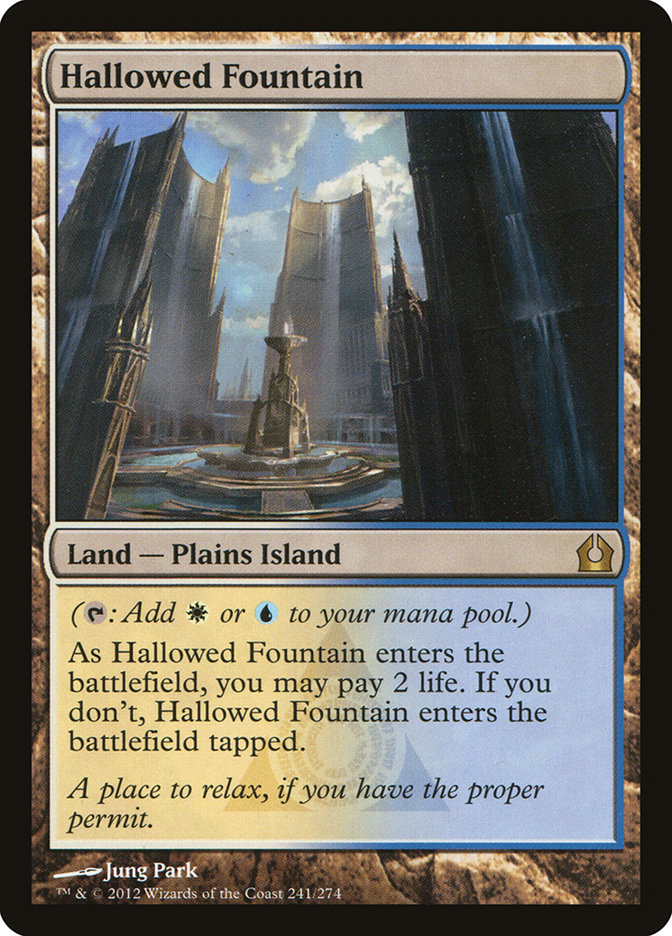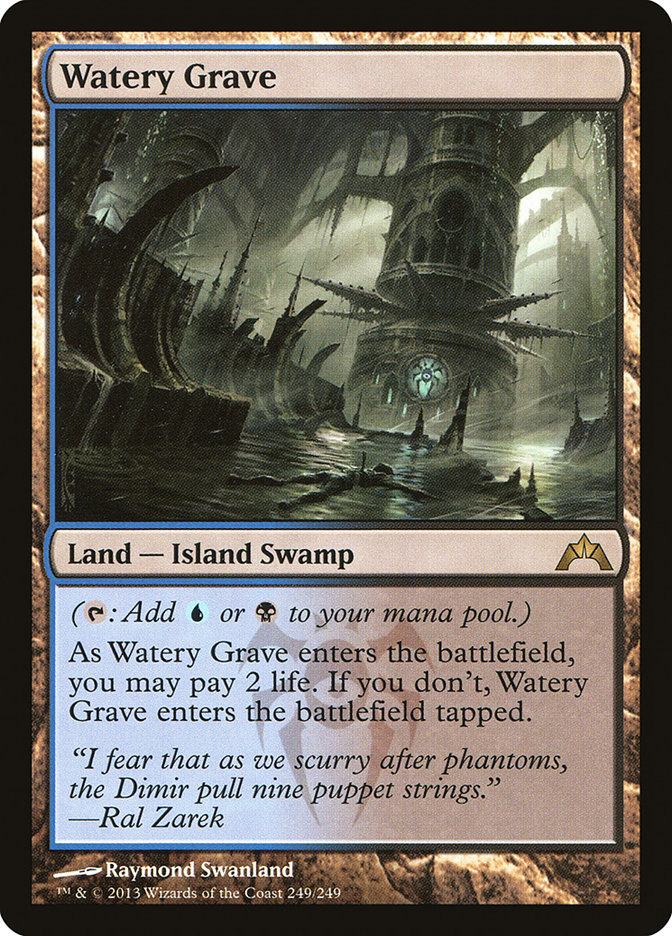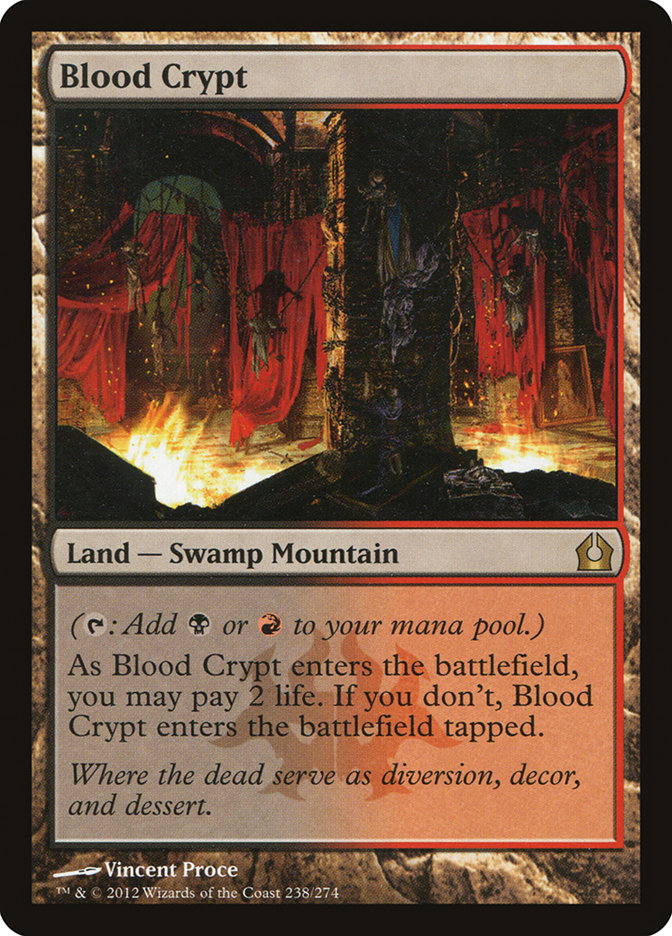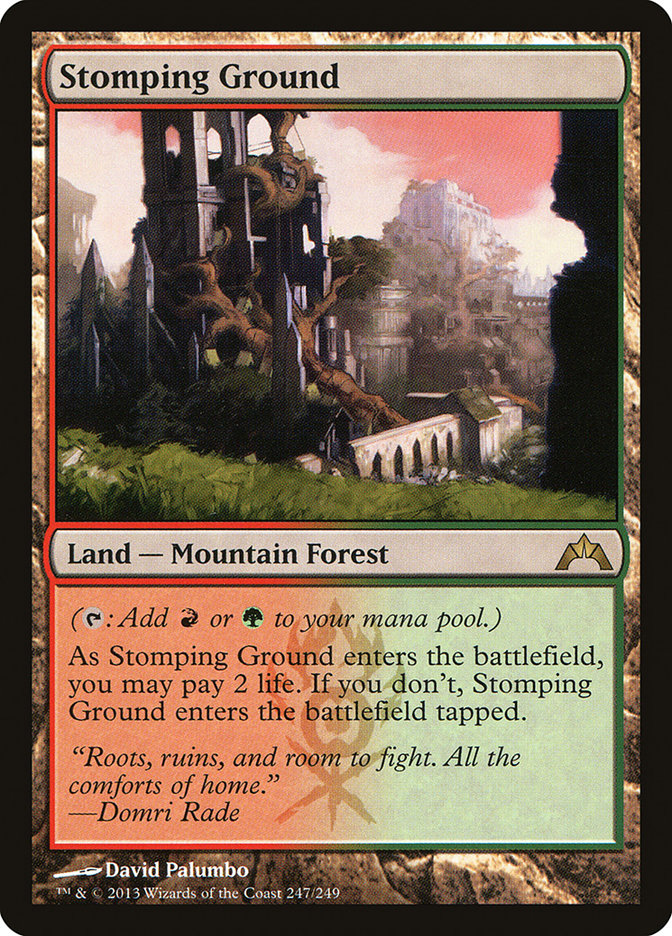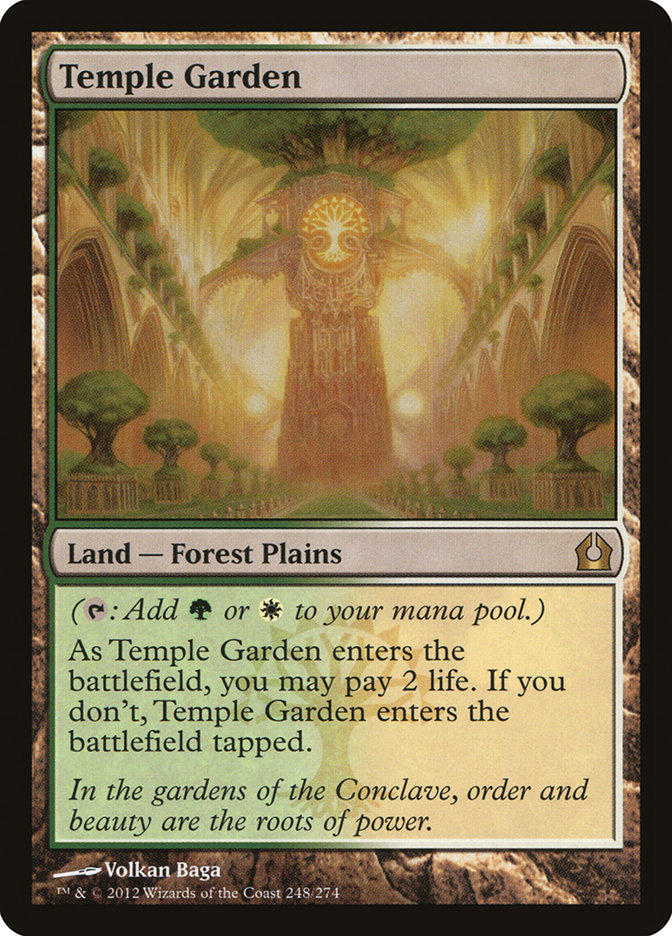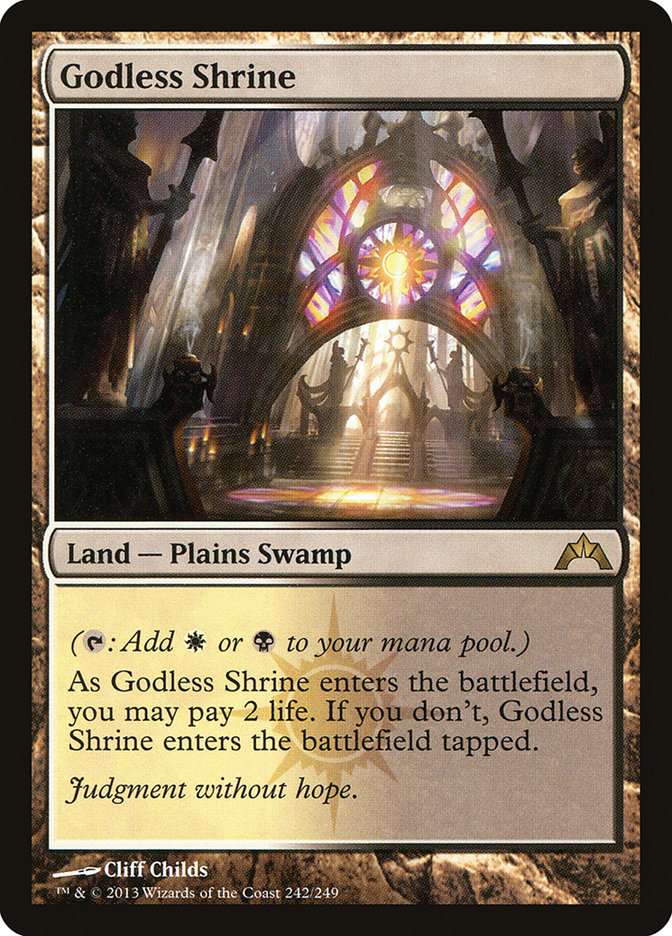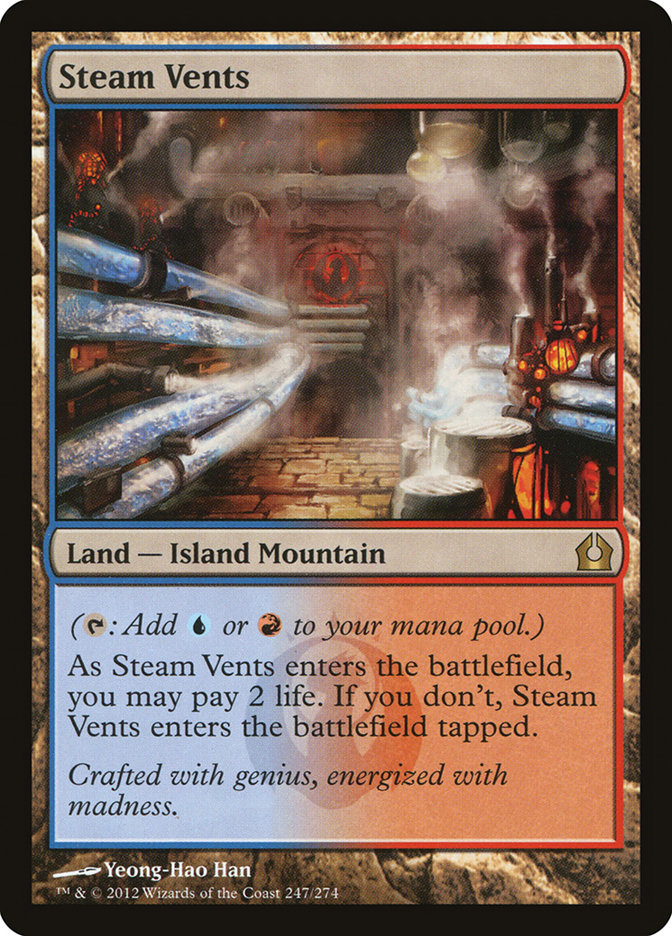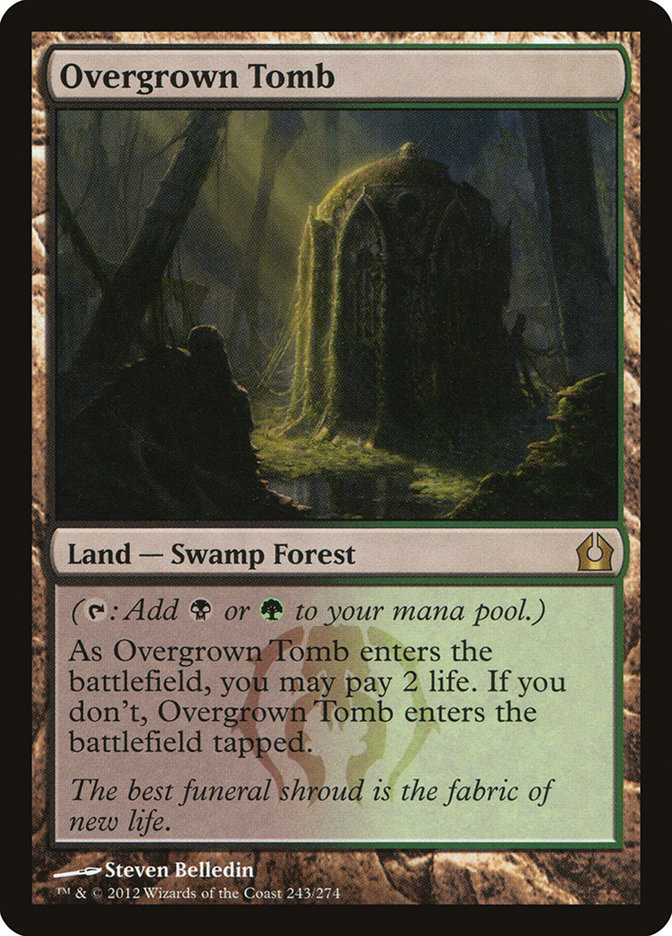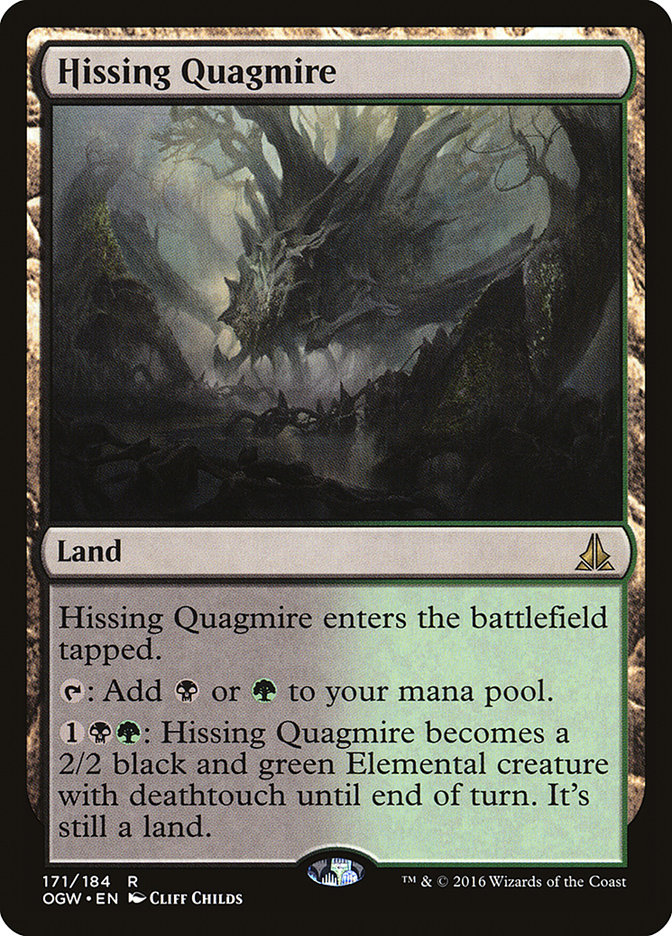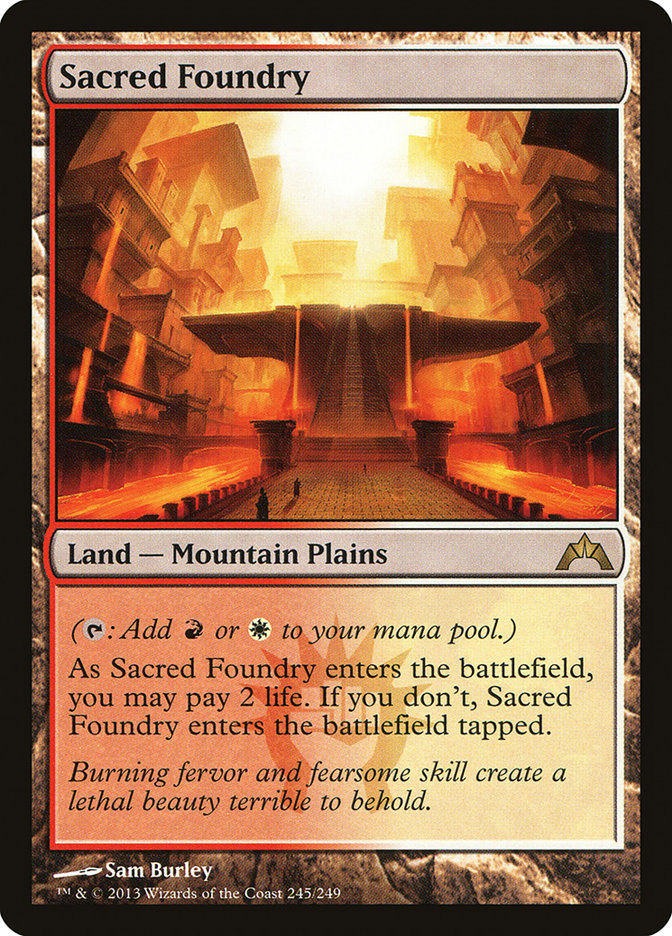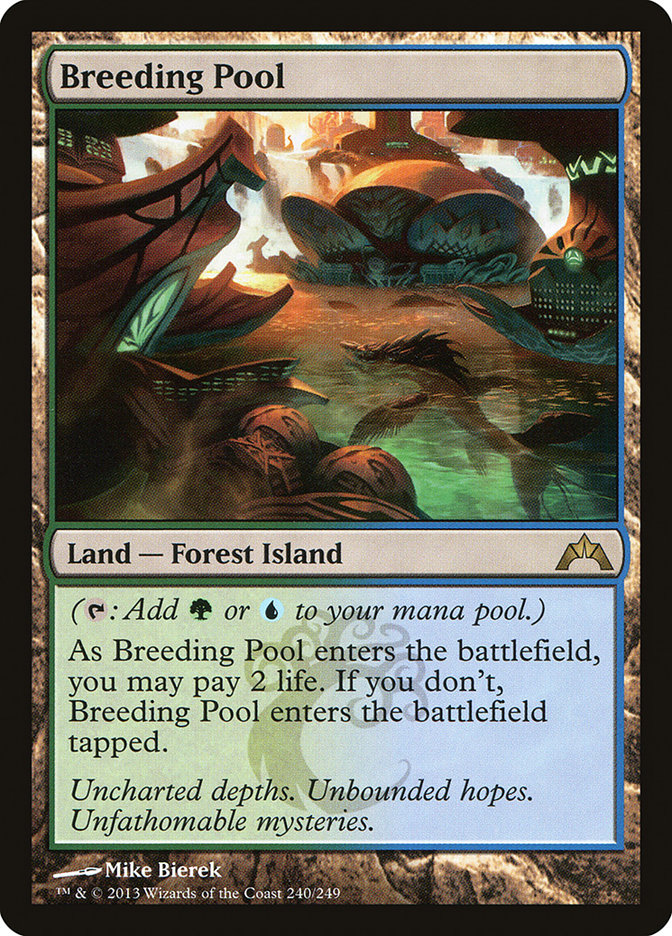Modern is in a great place right now. There are dozens of viable decks, and the format has been able to keep itself in check for three or four different “consensus best decks” since the banning of Gitaxian Probe and Golgari Grave-Troll.
One of the biggest things holding the format back at this point is that there’s a pretty steep learning curve. Earlier this year I had a client who wanted me to coach them on Modern from the ground up. They had never played the format, wanted to play Grixis Death’s Shadow, and wanted to possess the ability to identify decks from the first couple of cards the opponent played.
Last year I wrote a piece about the signals that are given from the first few cards that are played, and I took a similar approach with this person. The first thing that any player puts down in Modern is generally going to be a land. This means that the best approach to organizing our thoughts using a linear model is going to be best sorted by looking at each land that sees play in Modern and extrapolating from there.
Modern isn’t a small format, and as a result, this is going to take more than one article to finish. What we’ll do is break this down by lands in the format, explore what decks could be playing those cards, and take it a step further by narrowing each archetype down by observing the cards they play.
Shocklands are likely the most ubiquitous lands in Modern, and for good reason. They’re able to be grabbed by the Zendikar and Khans of Tarkir fetchlands, making color fixing for three-, four-, and even five-color decks is available at a low cost.
Hallowed Fountain generally tends to show up in decks that are blue-based featuring white cards.
Creatures (11)
Lands (19)
Spells (30)

The most popular deck playing Hallowed Fountain these days is the tempo-oriented Jeskai Control deck that was popularized by Harlan Firer and Jonathan Rosum. The easiest cards to identify a Hallowed Fountain deck as this version of Jeskai is via Spell Queller and Geist of Saint Traft. Most of the other cards in the deck tend to also be present in…
Creatures (3)
Planeswalkers (1)
Lands (21)
Spells (35)

The more traditional form of Jeskai Control plays a good number of the same cards, but the differences are in the use of Lightning Bolt to close the door versus its use to prolong the game.
Search for Azcanta and Glimmer of Genius are signals that a deck is looking to play a much longer game of Magic, rather than winning with a quick turn of the corner via Spell Queller.
Unless they aren’t playing red.
Creatures (4)
Planeswalkers (5)
Lands (17)
Spells (34)

U/W Control has started to edge its way back into competitive play. Look for the typical Serum Visions and Snapcaster Mage early, but Wall of Omens and Spreading Seas tend to signal that it may just be a U/W deck without any extra colors being thrown into the mix.
Creatures (36)
- 4 Meddling Mage
- 4 Noble Hierarch
- 4 Champion of the Parish
- 3 Mayor of Avabruck
- 4 Thalia, Guardian of Thraben
- 4 Mantis Rider
- 3 Reflector Mage
- 4 Thalia's Lieutenant
- 2 Thalia, Heretic Cathar
- 4 Kitesail Freebooter
Lands (19)
Spells (5)

Collins Mullen has been on an absolute tear with his Five-Color Humans deck the last few months. Most of the cards in the deck are pretty explanatory, and you don’t need a lot of help figuring out what’s going by the time they hit the battlefield.
Champion of the Parish in a Humans deck? What a surprise! Aether Vial in something that plays exclusively creatures and lands? What a twist!
Any of the five-color lands are also a huge signal for this archetype, particularly Cavern of Souls or Unclaimed Territory on “Human.”
Creatures (4)
Lands (18)
Spells (38)

The oldest combo deck still alive in Modern today is Ad Nauseam, and it doesn’t always play fetchlands. The easiest tipoff for this deck is a suspended Lotus Bloom on the first turn. Hallowed Fountain into Sleight of Hand is also a reasonable tipoff. After that, Pentad Prism is the biggest tipoff outside of combo pieces.
The deck also tends to play a good number of Temples from Theros block, but we’ll touch more on that later.
Creatures (27)
- 1 Birds of Paradise
- 4 Noble Hierarch
- 4 Drowner of Hope
- 4 Eldrazi Skyspawner
- 4 Eldrazi Displacer
- 4 Reality Smasher
- 4 Thought-Knot Seer
- 2 Matter Reshaper
Lands (20)
Spells (13)

Bant Eldrazi isn’t quite a “Hallowed Fountain deck,” but it does include the card. That being said, most of the creatures that this deck plays are castable off either Hallowed Fountain of Eldrazi Temple.
This deck is looking to use Noble Hierarch and Eldrazi Temple to ramp out medium-sized Eldrazi threats and have a better removal disruption suite than Eldrazi Tron. Yavimaya Coast is a dead giveaway for this archetype, and shocklands followed by Ancient Stirrings also point in the direction of Bant Eldrazi. Anything else that would come down early is an Eldrazi.
Watery Grave also primarily tends to lend itself to more controlling strategies of Modern, and it’s hard to talk about Modern decks without bringing up this one:
Creatures (16)
Lands (17)
Spells (27)

Grixis Death’s Shadow is one of the biggest decks in the format, and identifying it early is important. Similar to Hallowed Fountain tending to be in blue-based decks with white cards, Grixis Death’s Shadow is a U/B deck featuring some red cards. This means that getting a pair of Watery Graves early doesn’t mean someone isn’t on U/B Control. It’s still very possible that Death’s Shadow is the deck across the table.
The most common opening plays are Thoughtseize, Inquisition of Kozilek, and Thought Scour. The reason that Thought Scour tends to be the cantrip that Grixis Death’s Shadow pilots lead with is to power out their delve creatures, Gurmag Angler and Tasigur, the Golden Fang.
Creatures (12)
Planeswalkers (3)
Lands (18)
Spells (27)

It’s possible for Watery Grave to show up early from the Five-Color Death’s Shadow decks, but it will usually come after Overgrown Tomb. This deck is much closer to Jund Death’s Shadow with some blue cards and white cards, and we’ll talk about it more later.
Creatures (8)
Lands (17)
Spells (35)

Spell Snare aficionado Ryan Overturf has been putting up results with a more traditional take on Grixis Control and control players are following suit. This deck may look like Grixis Death’s Shadow at first, but the easiest way to set it apart are Grixis lands coupled with basic lands early, as Grixis Death’s Shadow frequently avoids grabbing its basic lands early because it’s more interested in paying life for shocklands in the name of cranking out Death’s Shadow.
The biggest differences in cards you’ll see early are Spell Snare, Electrolyze, countermagic not named Stubborn Denial, and Creeping Tar Pit.
Ad Nauseam can also play Watery Grave if it is a version playing fetchlands.
Blood Crypt is one of the most versatile shocklands in Modern, played in both very fair and very unfair decks.
Creatures (13)
Planeswalkers (4)
Lands (21)
Spells (22)

It’s hard to play Modern without running into Jund (or one of its spinoffs). Many seasoned Modern players are going to see the signs pretty quickly, but for the newer player, Jund may seem harder to pin down. What’s the point? What’s the deck doing?
The short answer is “not much.” There aren’t many inherent synergies between the cards. Most of what Jund is doing is trying to rip the opponent’s synergies apart and then capitalizing on the stumble this causes.
Blackcleave Cliffs and Raging Ravine are the signature lands of the archetype, with Dark Confidant being the biggest archetype-specific tell that the deck has early. Lightning Bolt, Inquisition of Kozilek, Thoughtseize, and Abrupt Decay are easy ways to get an idea of what’s going on as well.
Creatures (12)
Planeswalkers (3)
Lands (18)
Spells (27)

The Five-Color Death’s Shadow deck is trying to disrupt the opponent while capitalizing with undercosted creatures, this time Tarmogoyf instead of delve threats. Traverse the Ulvenwald is generally a big signal that this is what’s being played against. Multiple shocklands without a pain-free source of mana is another sign that Death’s Shadow is on the brain.
Other early cards specific to this version of Death’s Shadow are Mishra’s Bauble and the occasional Grim Flayer.
Like any Death’s Shadow deck, Street Wraith is pretty close to an instant dead giveaway. It’s only played in Death’s Shadow decks and….
Creatures (23)
Lands (16)
Spells (22)

This deck is doing a lot. Despite being named after Hollow One, the deck doesn’t fold if it never draws a copy of its namesake. This is much closer to a full-on Madness deck.
In addition to the previously mentioned Street Wraith, early cards to expect from this deck are Cathartic Reunion, Faithless Looting, Flameblade Adept, and Burning Inquiry. The other cards in the deck tend to be payoffs that signal everything else that’s going on.
Creatures (24)
Lands (20)
Spells (16)

Dredge is likely the best-known Faithless Looting deck in the format and uses many of the same enablers as the Hollow One deck. The biggest differences are in what it is using its enablers to accomplish:
All of these cards scream “Dredge!” Containing the namesake keyword in their text boxes might have something to do with it.
The biggest tipoff that a B/R deck is probably dredging is Insolent Neonate, as the dredge mechanic encourages discarding cards before drawing, rather than the other way around.
Creatures (27)
- 3 Simian Spirit Guide
- 4 Street Wraith
- 4 Fulminator Mage
- 4 Monstrous Carabid
- 4 Archfiend of Ifnir
- 4 Desert Cerodon
- 4 Horror of the Broken Lands
Lands (19)
Spells (14)
Sideboard

Are they cycling a bunch of creatures? That’s a Living End.
Grixis Death’s Shadow and Grixis Control are other decks we’ve already covered that play Blood Crypt.
Stomping Ground tends to slot itself into the more proactive decks in Modern. It’s hard for green to red to play defensively without the help of something else, and a G/R land means that the deck is playing two different colors that aren’t good at reacting. Short of red or green being splash colors, expect to be racing decks with Stomping Ground.
Creatures (8)
Lands (18)
Spells (34)

TitanShift centers itself around Valakut, the Molten Pinnacle. The deck’s goal is to put several Montains onto the battlefield alongside Valakut in order to kill the opponent three points at a time.
The deck tends to do this via a slew of ramp spells, and it isn’t too hard to pin down what’s going on when you see Mountains, some green lands, and these:
There are two different versions of the deck, the more redundant and consistent TitanShift listed above, and the more explosive Breach Titan that eschews most of its Scapeshifts in favor of Through the Breach:
Creatures (12)
Lands (16)
Spells (32)

There isn’t an enormous difference between the two decks, but Simian Spirit Guide should be a red flag for Through the Breach.
Chalice of the Void isn’t uncommon out of the Through the Breach versions, as the card is much better when Simian Spirit Guide is present to get it onto the battlefield ahead of curve.
Creatures (14)
Lands (17)
Spells (29)

Despite including Stomping Ground, today’s iteration of Modern Burn is a bit closer to a Sacred Foundry deck.
Burn is doing something very similar to the aforementioned Valakut decks, but the way that it deals three points of damage to the opponent is a little more…honest. Burn is pretty self-explanatory in that it’s trying to point burn spells at the opponent’s face, sacrificing cards in the name of direct damage.
The biggest cards you’ll see on the first turn that are exclusive to this deck are Goblin Guide, Monastery Swiftspear, Lava Spike, and Rift Bolt.
Creatures (23)
- 4 Kird Ape
- 4 Wild Nacatl
- 4 Goblin Guide
- 3 Ghor-Clan Rampager
- 4 Eidolon of the Great Revel
- 4 Monastery Swiftspear
Lands (20)
Spells (17)

The exception to some of that exclusivity is the Naya Zoo deck. Naya Zoo is as aggressive as the burn deck, but due to its spells sticking around a bit longer, they have the ability to deal more damage over the course of a few turns. The drawback is that they may also deal less damage, as the creatures are far easier to interact with than straight-up burn spells.
Wild Nacatl, Experiment One, and Kird Ape are the creatures most popular in these archetypes, and pre-sideboard copies of Atarka’s Command increase the likelihood that there are creatures lurking in their pilot’s deck.
When an opponent plays a Stomping Ground, also keep Five-Color Death’s Shadow, Jund, Living End, and Dredge on your radar.
Temple Garden decks tend to be proactive, but at an angle different from Stomping Ground. Temple Gardens play well with creatures, and as a result the most efficient bodies in the format tend to come in tow with the land.
Creatures (30)
- 4 Birds of Paradise
- 3 Eternal Witness
- 4 Devoted Druid
- 4 Kitchen Finks
- 4 Tidehollow Sculler
- 1 Noble Hierarch
- 1 Viscera Seer
- 1 Scavenging Ooze
- 2 Duskwatch Recruiter
- 1 Walking Ballista
- 1 Rhonas the Indomitable
- 4 Vizier of Remedies
Lands (19)
Spells (11)

Abzan Company (or “Counters Company” for the broader archetype that may play more colors) is a fair deck disguised as a combo deck. It’s easy to become fixated on the Devoted Druid / Vizier of Remedies combo, but remembering that there is a backup fair plan via Eternal Witness, Kitchen Finks, and Collected Company is important. The early identifiers in this matchup are the creatures: Viscera Seer, Devoted Druid, Duskwatch Recruiter, and Tidehollow Sculler.
Creatures (30)
- 3 Birds of Paradise
- 3 Eternal Witness
- 4 Devoted Druid
- 4 Noble Hierarch
- 1 Scavenging Ooze
- 1 Courser of Kruphix
- 1 Jace, Vryn's Prodigy
- 1 Reflector Mage
- 1 Tireless Tracker
- 3 Duskwatch Recruiter
- 4 Spell Queller
- 1 Walking Ballista
- 3 Vizier of Remedies
Lands (18)
Spells (12)

Bant Company functions on a similar axis but leans more on the fair game that Spell Queller provides, rather than the combo redundancy that the former deck has with Viscera Seer. This deck wasn’t mentioned under Hallowed Fountain due it being a Temple Garden deck with some blue cards. (Starting to notice a pattern with shocklands? An X/Y deck featuring Z cards is made possible due to the fetch-shock relationship.)
The easiest way to tell the two decks apart early is through the lands they play. Most of the blue cards in Bant Company are three-mana creatures, and it might not be as apparent at first, but about the time that Reflector Mage comes down, it’ll become obvious in a hurry.
Creatures (11)
Planeswalkers (4)
Lands (17)
Spells (28)

Abzan is cut from the same cloth as Jund but is meant to have a bit more game against other midrange decks via Lingering Souls. Grim Flayer being used over Dark Confidant is a signal that pressure is more important than raw cards.
This deck is quite good at looking like both Jund and Five-Color Death’s Shadow, but remember that most Jund decks don’t tend to play many copies of Blooming Marsh. Painless mana early is also a signal that something isn’t Death’s Shadow. On top of the mana, the Mishra’s Bauble / hand disruption mix should give away that an opponent is playing Abzan or something similar.
Creatures (35)
- 4 Llanowar Elves
- 1 Eternal Witness
- 4 Heritage Druid
- 4 Devoted Druid
- 4 Nettle Sentinel
- 1 Elvish Visionary
- 4 Elvish Archdruid
- 4 Ezuri, Renegade Leader
- 4 Elvish Mystic
- 4 Dwynen's Elite
- 1 Vizier of Remedies
Lands (15)
Spells (10)

Elves are pretty self-explanatory in what they’re doing. They’re casting Elves and then killing people with them. This deck is doing very similar things to Abzan Company, just from the other end of the spectrum. Where Abzan Company tends to do a combo deck impression with a backup fair gameplan, G/W Elves tends to be a fair deck with a backup combo.
When you see creatures like Llanowar Elves and Elvish Mystic that are near-strictly inferior to Birds of Paradise and Noble Hierarch, realize that they’re playing Elves, as the “Elf” creature type is what makes them worth registering. Heritage Druid and Dwynen’s Elite give away the fact that their casters are planning to play copious amounts of Elves in a single game.
Creatures (12)
Lands (19)
Spells (29)

If you see a Kor Spiritdancer or a creature with hexproof, then it’s G/W Hexproof. If you don’t see those cards, it either isn’t Hexproof or they didn’t get to play any cards.
It really is that simple.
Creatures (29)
- 1 Azusa, Lost but Seeking
- 4 Birds of Paradise
- 1 Eternal Witness
- 2 Aven Mindcensor
- 4 Noble Hierarch
- 4 Knight of the Reliquary
- 2 Scavenging Ooze
- 3 Voice of Resurgence
- 4 Courser of Kruphix
- 2 Tireless Tracker
- 2 Ramunap Excavator
Lands (16)
Spells (15)

Todd Stevens’s labor of love has finally broken its way into the Modern mainstream. The cards that most easily set this archetype apart from other G/W decks that people could be playing are Knight of the Reliquary, Ramunap Excavator, Courser of Kruphix, and Azusa, Lost but Seeking.
The deck’s tendency to fetch several times within a single game means that it typically has several basic lands on the battlefield at once. If there are more than two or three Forests and Plains on the table, it’s fairly safe to assume that the opponent is on G/W Company and not some Abzan or Bant Company deck.
Temple Garden is also played in Bant Eldrazi and Five-Color Humans!
White doesn’t have many unfair things going for it, and black oftentimes serves a more disrupting role in Modern. Godless Shrine is commonly found alongside tools to punish decks on a fair axis.
Creatures (29)
- 4 Flickerwisp
- 4 Tidehollow Sculler
- 4 Leonin Arbiter
- 1 Blade Splicer
- 4 Thalia, Guardian of Thraben
- 3 Wasteland Strangler
- 4 Eldrazi Displacer
- 4 Thought-Knot Seer
- 1 Thalia, Heretic Cathar
Lands (21)
Spells (10)

B/W Eldrazi Taxes is the current embodiment of “painfully fair.” Outside of Eldrazi Temple and Aether Vial, there isn’t anything more to this deck than casting a spell or two a turn before winning an incremental war of attrition. The main deck permanent forms of disruption in Thalia, Guardian of Thraben; Tidehollow Sculler, and Thought-Knot Seer are fantastic early but suffer as the game continues. As a result, B/W Eldrazi Taxes tries to close the door during the mid-game, when its disruption has taken effect and has been given time convert into an on-battlefield advantage.
Alongside Thalia, Guardian of Thraben, Leonin Arbiter combos with Ghost Quarter to cement a pseudo-mana denial strategy that isn’t meant to completely mana screw somebody out of the game. It’s more to buy time while the rest of the B/W Eldrazi deck’s creatures finish the job.
Other decks featuring Godless Shrine that we’ve already talk about are midrange Abzan and Abzan Company.
Steam Vents is the most versatile shockland in Modern right now, fueling aggro, control, and combo decks. Seeing an early copy of Steam Vents isn’t always going to narrow down everything that’s going on, but the following cards do a good bit to help that.
Creatures (8)
Lands (14)
Spells (38)

U/R Breach is the newest flavor of Steam Vents to make its way into Modern, and it’s easy to see why. While the deck can play the role of a U/R Control deck in the early turns, it can easily drop an Emrakul, the Aeons Torn onto the table and put the game out of reach.
The deck can be a little all over the place, but due to the deck being a Blood Moon deck, be conscientious of how a player’s manabase looks if they lead with a Steam Vents. If they’re fetching an abnormal amount of basic Islands, that’s a heavy indication that Blood Moon is on the way.
Izzet Charm and Spreading Seas are other cards attuned to this flavor of Steam Vents and can help set it apart from other decks that would otherwise be interested in an Island Mountain.
Creatures (8)
Lands (15)
Spells (37)

The go-to combo deck of current Modern, U/R Gifts Storm tends to just play cantrip after cantrip during the first few turns of the game, with Sleight of Hand being the most distinctive for this archetype, before trying to jam one of its two-mana cost reducers into a Gifts Ungiven-fueled win.
Other than Sleight of Hand, Goblin Electromancer and Baral, Chief of Compliance should be the biggest giveaways for this deck. It’s notable that Caleb Scherer has popularized a fetchless version of the deck that plays Shivan Reef. The Reef isn’t a common land in any other Modern deck, so a copy of the land means they’re likely planning to win with Grapeshot.
On top of these two decks, Steam Vents is also present in Jeskai Control (regular and tempo-oriented versions), Grixis Death’s Shadow, Grixis Control, and some Dredge lists (with the exclusive purpose of casting drawn copies of Narcomoeba and Prized Amalgam).
Overgrown Tomb is the shockland of nonblue disruption. All of those B/G Midrange decks from before? You’d better believe they’re Overgrown Tomb decks featuring other colors. Sometimes the B/G deck doesn’t even need other colors:
Creatures (15)
- 1 Eternal Witness
- 4 Dark Confidant
- 4 Tarmogoyf
- 3 Scavenging Ooze
- 1 Kalitas, Traitor of Ghet
- 2 Tireless Tracker
Planeswalkers (3)
Lands (21)
Spells (21)

It can be a bit difficult to figure out that somebody is on a two-color deck when Jund and Abzan are both so popular, especially when most of the cards in this deck are present in its three-color counterparts. Hissing Quagmire is the big exception.
The biggest strike against Hissing Quagmire compared to other available options is that it’s just so fragile. It’s not great at blocking and surviving, and it doesn’t represent a reasonable clock.
After three or four lands without a third color, it’s safe to start assuming that they are either a two-color deck or that their third color doesn’t matter because they can’t cast spells outside of the two colors of mana they control.
Creatures (34)
- 4 Llanowar Elves
- 4 Heritage Druid
- 4 Nettle Sentinel
- 4 Elvish Visionary
- 4 Elvish Archdruid
- 2 Ezuri, Renegade Leader
- 4 Elvish Mystic
- 4 Dwynen's Elite
- 4 Shaman of the Pack
Lands (15)
Spells (11)

G/B Elves is both more and less fair than its G/W counterpart. While it lacks the arbitrarily large combo that Devoted Druid can supply, Shaman of the Pack means that this deck relies less on attacking.
Outside of the creatures mentioned with the first Elves deck, take note on the lands that an Elves deck is playing. Black lands obviously tend to point towards black cards, but if a player is on exclusively green lands and names “Elf” with Cavern of Souls, then they aren’t looking to fix their mana for a Vizier of Remedies like the white variant would.
The black variant of the deck also tends to play more copies of Elvish Visionary, and even plays Throne of the God-Pharaoh from time to time.
When an opponent plays a copy of Overgrown Tomb, be sure to also keep Five-Color Death’s Shadow, Jund, midrange Abzan, Living End, and Abzan Company in mind.
Sacred Foundry tends to find its way into fair decks on opposite ends of the spectrum. Most Sacred Foundry decks are trying to be very aggressive, or else very slow. Take a look:
Creatures (10)
Lands (16)
Spells (34)

Rather than lump all of the Burn decks together under Sacred Foundry, we put the Naya version up with Stomping Ground as a segue into Zoo. The Mardu version of the deck is a bit more linear. Bump in the Night is the biggest non-land tell before sideboarding.
Most of the differences between this and the Naya version of the deck are accented after sideboarding, with Rain of Gore, Rakdos Charm, and Collective Brutality all being possible things to see from across the table.
Creatures (4)
Planeswalkers (7)
- 2 Ajani Vengeant
- 1 Elspeth, Knight-Errant
- 1 Nahiri, the Harbinger
- 2 Chandra, Torch of Defiance
- 1 Gideon of the Trials
Lands (14)
Spells (35)

W/R Prison has taken several shapes over the last year or two, but the most recent iteration has upped the number of “lock pieces” that it plays by adding Ensnaring Bridge to its previous cocktail of Blood Moon and Chalice of the Void.
The easiest way to single this deck out is by the strange array of W/R multicolor lands that it tends to play (in addition to Sacred Foundry). Rugged Prairie and Temple of Triumph don’t really show up anywhere else, and past that, there aren’t very many things that are going to come down early. The deck doesn’t play any one-drops in order to avoid tripping over its own copies of Chalice of the Void, increasing the value of Simian Spirit Guide.
In addition to the Naya Burn deck referenced under Mardu Burn, Jeskai Control (traditional and tempo) can play copies of Sacred Foundry.
Breeding Pool really only has one deck where it’s played without splashing other colors, combining creatures and spells alike:
Creatures (14)
Lands (18)
Spells (28)

Infect is another deck on this list that’s withstood the test of time despite suffering from a ban in recent years. The deck is similar to Hexproof in that most of the time you’ll see one of its creatures with the infect ability. The key difference here is that Noble Hierarch can become more than a little formidable with the help of a flurry of pump spells.
Breeding Pool into Noble Hierarch usually means Infect, though it can occasionally be Bant Eldrazi or Bant Company as well.
Stay Tuned!
Shocklands cover a large chunk of the format, but what else is there?
Make sure to check out the second half of this article series later this week!


